|
|
|
Sort Order |
|
|
|
Items / Page
|
|
|
|
|
|
|
| Srl | Item |
| 1 |
ID:
190964
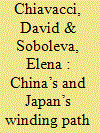

|
|
|
|
|
| Summary/Abstract |
In the early 1980s, the People’s Republic of China (PRC) and Japan joined the international refugee regime. This timing similarity is puzzling due to the stark differences between the PRC as a communist and authoritarian state versus Japan as a prime example of capitalist development and democratization. Moreover, although both signed the 1951 Refugee Convention and the 1967 Refugee Protocol without major reservations, neither of them has fully implemented these treaties. Discussions regarding the PRC’s and Japan’s engagement with the international refugee regime tend to start with the beginning of the Indochina refugee crisis in 1975. However, this article shows that the early decades of their interaction with the international refugee regime are of crucial importance for a full understanding of the timing and form of accession to the international refugee regime. Although the Southeast Asian refugee crisis played an important role as a trigger, it was the changing character of the international refugee regime and the transformations of state identity in both countries that set the ground for the signing of the refugee-related conventions.
|
|
|
|
|
|
|
|
|
|
|
|
|
|
|
|
| 2 |
ID:
190956


|
|
|
|
|
| Summary/Abstract |
The 1906 Universal Exposition hosted in Milan was a defining moment for the late Qing in terms of its fisheries development. The exhibition not only allowed China to portray its strategic focus on its fisheries but also its determination to be seen as a modernized and progressive sea power in Asia. China’s involvement in this world’s fair also paralleled the process of political and economic consolidation of some of the country’s intellectuals at the turn of the nineteenth century. These intellectuals’ accumulated experience, common goals, and international consciousness made it possible to assemble a group of professional experts I refer to as the ‘new fisheries elites’, who were able to construct the image of China as a modern fisheries power, if not a sea power, at various levels. The first part of this article will situate this exposition within the final two decades of the Qing Empire in the context of the political, social, and cultural transformation that was taking place around the world at the time. China’s presence at the world’s fair during this period displayed the adjustments of a changing and dynamic national image in terms of both its national circumstances and its international situation. The second part will then move on to discuss in what ways the Milan exposition was conceived by elites such as Zhang Jian, Luo Cheng, and Guo Fengming as a paradigmatic setting in which to showcase China’s drive toward modernity and becoming a sea power. Although China had participated in several other universal expositions, the Qing court had clearer and more pragmatic objectives in its participation in Milan in 1906. This was to demonstrate its recent progress and to change the common impression of China as an insecure, inexperienced, and incompetent country in terms of its fisheries governance and maritime vision. To produce this image, Zhang Jian and his team undertook a sensible and impressive approach towards presenting to the world China’s maritime awareness and the long historical continuity between this country and the sea. This was a conscious effort to produce an ideal of what a modern, progressive maritime China should look like.
|
|
|
|
|
|
|
|
|
|
|
|
|
|
|
|
| 3 |
ID:
190958


|
|
|
|
|
| Summary/Abstract |
This article foregrounds the postcolonial museum as a new source, and site, from which to write South Asian histories of partition and its aftermath. It focuses on collecting practices in India within East Punjab, following the partition of the British-era Punjab province in 1947 between India and Pakistan. Tapping hitherto-unused archival sources, it reveals the considerable financial investment and drive to collect at this time, belying the idea of museums being ‘dead’ colonial assets, and demonstrates their centrality to how citizenship and belonging were articulated (or withheld) in independent India. Some discoveries have far-reaching implications for both historians and museum professionals. The article also shines a light upon a new range of actors—both named and nameless, professional and citizen—who have been marginal to historical enquiry thus far. Moving beyond the familiar colonial templates within which museums in the region have until now been studied, it asks critical questions of the postcolonial museum in South Asia by interrogating the relationship between collections, and the Indian nation-state and its subsidiaries.
|
|
|
|
|
|
|
|
|
|
|
|
|
|
|
|
| 4 |
ID:
190953


|
|
|
|
|
| Summary/Abstract |
One of the epic national narratives of modernization and development in China is the story of Beidahuang (‘Great Northern Wilderness’) in the country’s northeast. The term ‘Beidahuang’ refers originally to state-sponsored campaigns, starting in the 1950s, that involved the enlistment of tens of thousands of People’s Liberation Army soldiers, educated youth, and Communist Party cadres. Their task was to transform the vast northeast ‘wasteland’ into productive farmland that would feed the nation while securing the nation’s borders with Russia. This article examines the significance of Beidahuang as a feature of the environmental discourse in China’s northeast borderlands, focusing on the first decade of the twenty-first century when the Chinese state was establishing more systematic measures for addressing environmental concerns. In the context of the northeast borderland, the massive deforestation that resulted from the socialist campaigns to transform ‘wasteland’ into productive farmland has left a controversial legacy for regional elites grappling with the Party leadership’s turn towards environmental conservation as an emerging political priority. This article suggests that the ongoing importance of the ‘Great Northern Wilderness’ in the Chinese cultural imagination has shaped the ways in which regional elites frame environmental issues in relation to economic development, nationalism, and border relations with Russia.
|
|
|
|
|
|
|
|
|
|
|
|
|
|
|
|
| 5 |
ID:
190962
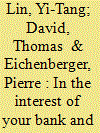

|
|
|
|
|
| Summary/Abstract |
This article examines China’s path to joining the International Chamber of Commerce (ICC), a private international organization founded in Paris in 1920, of which China was a member from 1931–1949 and from 1994 onwards. The article charts the actors and debates behind two meaningful encounters. The first took place while the Nanjing government was raising funds for economic reconstruction, and the ICC aimed to mediate China’s fundraising efforts through private multilateral channels. The second was in the 1980s, when the People’s Republic was seeking to enter the world trade system. ICC members acted as educators and facilitators of world trade practicalities for the People’s Republic, which eventually rejoined the ICC in 1994. The article draws on Chinese, European, and American source material collected from governments, chambers of commerce, and private businessmen to make a twofold contribution. First, it adds nuance to the narrative of China’s economic internationalization by identifying an important non-governmental diplomatic channel. Second, it questions the ICC’s self-proclaimed identity as a non-political economic organization by showing how the political was indissociable from the economic when it came to China’s membership.
|
|
|
|
|
|
|
|
|
|
|
|
|
|
|
|
| 6 |
ID:
190950
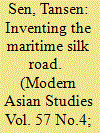

|
|
|
|
|
| Summary/Abstract |
Although inspired by the nineteenth-century term ‘Silk Road(s)’, the phrase ‘Maritime Silk Road’ has its own origins, connotations, and applications. This article examines the emergence of the latter term as a China-centric concept and its various entanglements since the early 1980s, involving the People’s Republic of China’s (PRC) political bodies, academia, the ‘open door’ policy, the pursuit of World Heritage listings, and the current ‘Belt and Road Initiative’. These entanglements, the article contends, have resulted in the emergence of what could be called a ‘Maritime Silk Road’ ecosystem in the PRC. The analysis of this ecosystem presented in the article reveals not only the processes through which a narrative on China’s engagement with the maritime world has been constructed over time, but also its association with issues of national pride, heritage- and tradition-making, foreign-policy objectives, and claims to territorial sovereignty. As such, the ‘Maritime Silk Road’ must be understood as a concept that is intimately entwined with the recent history of the PRC and distinct from its nineteenth-century antecedent, which was used as a label for overland connectivity.
|
|
|
|
|
|
|
|
|
|
|
|
|
|
|
|
| 7 |
ID:
190959
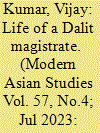

|
|
|
|
|
| Summary/Abstract |
This article discusses Chaudhari Mulkiram (April 1910–August 1954) and the contesting ideologies, memories, histories, and socio-political conditions surrounding his career from the 1920s to the mid-1950s. Mulkiram belonged to the Dhangar, a sub-caste of the Khatik caste in Meerut. He was the first Dalit of the United Provinces (UP) who qualified for the Public Service Commission in 1939. This article shows his socio-religious and socio-political relations and responses to the Arya Samaj, Congress, and Scheduled Caste Federation. It reveals how the representatives of these agencies portrayed his life and work. This article also discusses how his relations and responses helped and influenced his caste members in the western UP. It argues that the Arya Samaj, Harijan Sevak Sangh, and Congress used the first generation of Dalit civil servants like Mulkiram to cultivate local leaders and to mobilize local Dalits, peasants, labourers, and villagers to act in their political interests against Ambedkar’s movement. Hence, in the 1940s and early 1950s, Mulkiram presented himself as a Gandhi bhakt, Jan Neta (public leader), and Sanyasi (household monk and socio-religious reformer).
|
|
|
|
|
|
|
|
|
|
|
|
|
|
|
|
| 8 |
ID:
190961


|
|
|
|
|
| Summary/Abstract |
This article makes an intervention in the study of the May Fourth Movement by examining the role the mass media played in the diplomatic and domestic mobilization processes set in motion by China’s experience at the Paris Peace Conference. In contrast with the mainstream narrative that constructs the May Fourth Movement as a spontaneous response to the loss of Shandong at Versailles, this article shows that it was preceded by a proactive diplomatic strategy to mobilize ‘public opinion’ over the Shandong question. The Chinese delegation’s decision to launch a media campaign in support of their diplomatic agendas at Versailles inadvertently turned domestic media into a platform for political debate. As a result of competition between the political elites who dominated the mediascape, discussions over the Shandong question shifted from focusing on international diplomacy to domestic politics in the spring of 1919. An examination of the ‘media war’ during the May Fourth Movement further demonstrates that the political elites’ variable ability to adopt media strategies to shape and channel public opinion resulted in changing the political landscape of the post-May Fourth era. By focusing on the role of the mass media in the diplomatic and domestic mobilization in China’s strategy at Versailles and during the May Fourth Movement, this article forges new connections between the international and the domestic. It also invites further reflections on the nature of the May Fourth Movement by showing that the media was a tool of political mobilization that connected the political elite to the masses.
|
|
|
|
|
|
|
|
|
|
|
|
|
|
|
|
| 9 |
ID:
190951


|
|
|
|
|
| Summary/Abstract |
In the intellectual history of modern Japan, the late 1880s epitomized the Meiji government’s effort to ‘civilize’ through Westernization, driven by the social Darwinian vision of the survival of the fittest. During this period in the United States, the ideas of civilization theory, informed by the very antithesis of the Meiji state’s understanding, surfaced in the life and work of the aspiring young naturalist-botanist Minakata Kumagusu. He imagined a ‘different kind of civilization’ as he re-examined the nature of social evolution in microbes by turning to Indian-and-Chinese-derived knowledge of his home region of Kii, Japan. Buddhism, persecuted by the Meiji regime, most notably enabled his scientific enquiry, while the encyclopedic work of Wakan Sansai Zue (The Illustrated Three Knowledge of Sino-Japan) became another key inspiration. Chinese historiography and Confucian thoughts additionally facilitated his reasoning.
What interconnected all of these strands was what the author refers to as ‘queer nature’: the basis for truths whose ontological and experiential qualities resembled the microbe slime mould. Similar to this microbe that captured Kumagusu’s imagination, with queer nature the process of knowing defied the epistemological dichotomies and hierarchies that were fundamental to the social Darwinian theory of evolution. Experientially, it attracted the knower’s attention, induced their desire for intimacy with strange and curious others, and propelled greater intellectual enquiries. The article thus demonstrates a queer theory of intellectual history rooted in modern Japan, whose intellectual lineage derived from India and China instead of the West.
|
|
|
|
|
|
|
|
|
|
|
|
|
|
|
|
| 10 |
ID:
190957
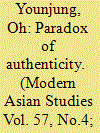

|
|
|
|
|
| Summary/Abstract |
Mitsukoshi, a famed Japanese department store, opened a Korean Product Showroom in its Keijō (Seoul) branch in 1930. The Korean Product Showroom was the only space decorated in ‘Korean style’ within the Keijō Mitsukoshi building, which was designed in Neo-Renaissance style, much like its flagship store in Tokyo. This showroom offered Korean artefacts as luxury souvenirs aimed at Japanese tourists. The most popular items sold in the showroom were Koryŏ-style celadon ware and lacquerware inlaid with mother-of-pearl, which Mitsukoshi ordered from local workshops in Korea. Interestingly, the workshops were run by Japanese entrepreneurs and sometimes even employed Japanese artisans. This article examines the inauthentic authenticity of ‘Korean style’ and ‘Korean products’ that the Japanese produced and consumed in colonial Korea. It does not imply that only Koreans are entitled to represent Korean culture. There have been many studies asserting that Korean culture was destroyed and distorted from its ‘original’ forms by Japan’s cultural genocide during the colonial period. This article neither is interested in repeating such criticism nor focuses on recuperating genuine Koreanness. Rather, it explores why the Japanese desired ‘pure Korea’ and how that desire shaped ‘Korean style’ and ‘Korean products’ through Keijō Mitsukoshi’s Korean Product Showroom and its products.
|
|
|
|
|
|
|
|
|
|
|
|
|
|
|
|
| 11 |
ID:
190960


|
|
|
|
|
| Summary/Abstract |
Between 2014 and 2022, the Bharatiya Janata Party (BJP) made a determined bid to establish its electoral and discursive dominance in regions beyond its traditional strongholds in Northern and Western India. In the North-east, in the Christian-majority states of Mizoram, Meghalaya, and Nagaland, it encountered fierce hostility from the Church which exercised a hegemonic control over the religious, social, and political life in these states. This article focuses on the political tussle between the BJP and the Church in this time period and attempts to explore the deeper ideological contestations and competing narratives underlying this struggle and their implications for the Indian political discourse. These include contestations over the very conceptualization of secular democracy in India and the role of religion in it; different understandings of religious conversions and freedom of conscience; and the conflicting agendas around the categories of ‘tribe’, ‘indigenous people’/‘adivasi’, and ‘janjati’/‘vanvasi’.
|
|
|
|
|
|
|
|
|
|
|
|
|
|
|
|
| 12 |
ID:
190952


|
|
|
|
|
| Summary/Abstract |
A variety of wormwood, Artemisia cina, once grew abundantly in the Syr-Darya province of Russian Turkestan. Santonin, a drug derived from it, was in high demand. Flowers harvested by Kazakhs were handed over to intermediaries to be processed in Europe, but from the 1880s entrepreneurs from different parts of the Russian empire established their own chemical plants in Chimkent and Tashkent. They pressured the Russian imperial government to restrict the rights of the Kazakhs on land where Artemisia cina grew, and grant them the exclusive right to exploit this resource. These entrepreneurs used conservationist arguments and advocated a ‘cultured’ approach to the management of natural resources located on supposedly ‘State land’. These attempts collided with the usage rights of the Kazakhs, as defined by Turkestan’s governing Statute. By shifting the argument to the political, rather than legal, level, the industrialists eventually gained a monopoly to the exclusion of local entrepreneurs and even assumed State-like functions. This article reconstructs this controversy and allows a glimpse into the evolving claims to natural resources in the ‘periphery’ by both Tsarist colonial power and the Kazakhs themselves. The article also explores the features of autochthonous and Russian entrepreneurship and situates Turkestan in a web of trade connections to the global pharmaceutical industry.
|
|
|
|
|
|
|
|
|
|
|
|
|
|
|
|
|
|
|
|
|